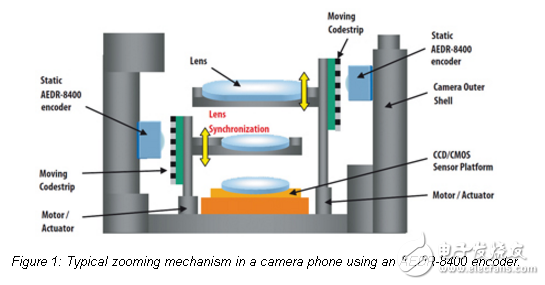
资料下载

光学编码器的优点
光学编码器的优点
手机相机上的光学变焦功能避免了数码变焦造成的质量下降,但目前的实现往往是噪音大、体积大、耗电大。Avago的aedr-8400编码器采用了一种独特的方法,解决了这些问题。
介绍
广泛的商业应用使用带有变焦机构的照相机。也许最普遍的应用是相机电话。相机变焦的关键设计标准包括低功耗,当然还有空间限制。本文介绍了一种光学编码器技术,它为相机变焦设计提供了一种新的方法来应对这些挑战。
光学和数字变焦
相机手机可能有光学变焦、数码变焦,或者两者都有。光学变焦改变相机镜头的有效焦距,使得原始图像被放大,并可由CCD或cmos图像传感器捕获。随着放大倍数的增大,光被分散到整个图像传感器上,并且所有的像素都可以使用。光学变焦可以被解释为一个真正的变焦,这将提高拍摄图像的质量。

Digital zoom, on the other hand, is a bit different. In this case, a software algorithm is applied rather than a hardware movement (i.e., changes in lens positioning) to magnify the image. Such magnification involves only a certain portion of the captured image. This is known as the interpolation technique. Using such a technique, or algorithm, requires information to be added in order to enlarge the corresponding image portion. It may seem that the captured image is being magnified. However, only a certain portion of the real image information is being utilized and the rest of the image is coming from the interpolation outputs.
One thing worth mentioning is that the higher the digital zoom, the smaller the portion of real information that is taken. Therefore, many of the originally captured pieces of information on the image sensor will be discarded and more interpolated image data will be incorporated in the resultant image.
声明:本文内容及配图由入驻作者撰写或者入驻合作网站授权转载。文章观点仅代表作者本人,不代表电子发烧友网立场。文章及其配图仅供工程师学习之用,如有内容侵权或者其他违规问题,请联系本站处理。 举报投诉
- 相关下载
- 相关文章





